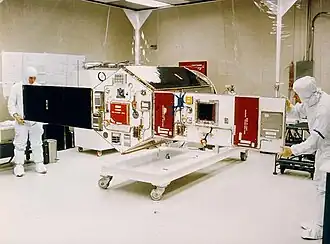Advanced Photovoltaic & Electronic Experiment
 | |
| Operator | NASA / DARPA |
|---|---|
| COSPAR ID | 1994-046A |
| SATCAT no. | 23191 |
| Mission duration | 1 year (design life) 3 years (target) 22 months (achieved) |
| Spacecraft properties | |
| Bus | PegaStar |
| Manufacturer | Orbital Sciences |
| Launch mass | 260 kilograms (570 lb) |
| Start of mission | |
| Launch date | August 3, 1994, 14:38 UTC |
| Rocket | Pegasus |
| Launch site | Balls 8, Edwards Runway 04/22 |
| Contractor | Orbital Sciences |
| End of mission | |
| Last contact | June 4, 1996 |
| Orbital parameters | |
| Reference system | Geocentric |
| Regime | Low Earth |
Advanced Photovoltaic and Electronics Experiments, also known as APEX, was a satellite-based science mission launched into Low Earth orbit on August 3, 1994, by a Pegasus rocket. The mission successfully tested the use of photovoltaic and electronic components in space.[1]
References
- ^ "APEX (P90-6)". Gunter's Space Page. Retrieved April 12, 2019.